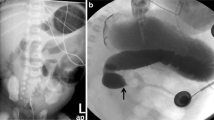Abstract
Midgut volvulus with extensive intestinal necrosis in the newborn period and in early infancy and childhood presents a difficult therapeutic dilemma of how to control sepsis and preserve a maximum and life-sustaining amount of large and small intestine. This problem is similar to that faced in cases of necrotizing enterocolitis with extensive intestinal ischemia and necrosis. The successful use of the “patch, drain, and wait” approach in necrotizing enterocolitis suggested its potential usefulness in midgut volvulus with similarly extensive necrosis in early life [7]. The basic principles of this approach involve maximum bowel salvage by avoidance of both resection and enterostomy; extensive bilateral Penrose drainage of the peritoneal cavity to provide an exit for sepsis and debris for peritonitis control; and “de facto” enterostomies for potential enteric fistula capture, gastrostomy for upper gastrointestinal tract venting and decompression, and Broviac catheter placement for long-term hyperalimentation. Three cases involving the successful use of this approach are reported.
Similar content being viewed by others
References
Andrassy RJ, Mahour GH (1981) Malrotation of the midgut in infants and children; a 25-year review. Arch Surg 116: 158–160
Dudrick SJ, Wilmore DW, Vars HM, Rhoads JE (1968) Long-term total parenteral nutrition with growth development and positive nitrogen balance. Surgery 64: 134–142
Goldman CD, Rudloff MA, Ternberg JL (1987) Cytoprotective agents in experimental small bowel volvulus. J Pediatr Surg 22: 260–263
Krasna IH, Becker JM, Schwartz D, Schneider K (1978) Low molecular weight dextran and reexploration in th management of ischemic midgut volvulus. J Pediatr Surg 13: 480–483
Moore TC, Stokes GE (1953) Congenital stenosis and atresia of the small intestine. Surg, Gynecol Obstet 97: 719–730
Moore TC (1986) Jejunal atresia with midgut deletion. J Pediatr Surg 21: 951–952
Moore TC (1989) Management of necrotizing enterocolitis by “patch, drain and wait”. Pediatr Surg Int 4: 110–113
Moore TC, Salzberg AM, Talman EA (1970) Jejuno-ileo-colic intubation and plication for intestinal obstruction with massive adhesions in infancy. Surgery 67: 364–368
Scheflan M, Galli SJ, Perrotto J, Fischer JE (1976) Intestinal adaptation after extensive resection of the small intestine and prolonged administration of parenteral nutrition. Surg Gynecol Obstet 143: 757–762
Stewart DR, Colodny AL, Daggett WC (1976) Malrotation of the bowel in infants and children; a 15 year review. Surgery 79: 716–720
Wilmore DW, Dudrick SJ, Daly JM (1971) Role of nutrition in the adaption of the intestine after massive resection. Surg Gynecol Obstet 132: 673–680
Author information
Authors and Affiliations
Rights and permissions
About this article
Cite this article
Moore, T.C. Management of midgut volvulus with extensive necrosis by “patch, drain, and wait” in early infancy and childhood. Pediatr Surg Int 6, 313–317 (1991). https://doi.org/10.1007/BF00178646
Accepted:
Issue Date:
DOI: https://doi.org/10.1007/BF00178646




